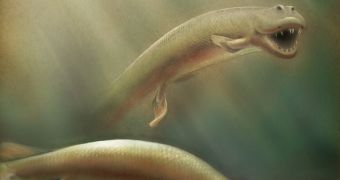Scientists at the University of Chicago determined in a new investigation that the earliest tetrapods (four-legged animals) to walk the surface of the planet after climbing out of the oceans were capable of more efficient and effective motions that originally estimated.
In a paper published in this week's early online issue of the esteemed journal Proceedings of the National Academy of Sciences (PNAS), the UC group argues that the first creature to make its way on land lived around 375 million years ago.
This conclusion is based on an analysis of the Tiktaalik roseae fossil, which was discovered on Canada's Ellesmere Island back in 2004. After the finding was made, researchers published incomplete results of their work in various journals, but it was not until recently that all sections of the ancient animal were released from their stony prison.
The new study indicates that the creature, a transitional individual between tetrapods and lobe-finned fishes that lived exclusively in the ocean, had well-developed, large pelvic bones, as well as front fins that resembled legs. The pelvic bone arrangement is a clear indicator of the fact that it could walk well.
The fossil also revealed that the first four-limbed vertebrates ever to walk on land developed towards the end of the Devonian period (419 to 358 million years ago), NPR reports. The creature may have also sported a mobile neck and primitive lungs that enabled it to breathe in the atmosphere.
At the same time, Tiktaalik retained its scales, fins and gills, that it inherited from lobe-finned fishes. The animal was able to support itself on the ground through the use of shoulders, partial wrists and elbows on its fore fins, or proto-legs. These conclusions were drawn from analyses of the front half of the animal.
When the fossil was finally removed from its casing in its entirety, experts were able to analyze its back half, and learn more about its pelvis and hind legs. The new study was authored by Neil Shubin, Ted Daeschler and Farish A. Jenkins Jr. and preparator Fred Mullison, the same team that released the other study of Tiktaalik.
The PNAS paper reveals the existence of a large pelvic girdle in the fossilized specimen, featuring areas where large support muscles may have attached. The hip joint on this creature was oriented in a way that did not accurately resemble orientations seen in either fish, or tetrapods.
“It's what we've all been waiting for. Until this discovery, we weren't able to see the changes by which the pelvic fins of the fish became much larger and more robust, and gradually turned into the tetrapod hind limb,” comments the curator of vertebrate paleontology with the Museum of Zoology at the University of Cambridge, Jennifer Clack.

 14 DAY TRIAL //
14 DAY TRIAL //